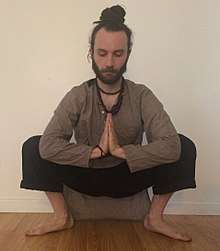Mālāsana
Mālāsana is a term for various squatting āsanas in hatha yoga and modern yoga as exercise.[1][2]


Traditionally, and in B. K. S. Iyengar's Light on Yoga, mālāsana, or Garland Pose, is used for a different squatting pose with the feet together and the back rounded with multiple hand placement variations.[3] When the hands are bound around the back this pose is also called kanchyasana ("golden belt pose").[2]
In the West, the term malasana is also used for the "regular squat pose", also called upavesasana,[4] in which the hand palms are folded together in the so-called namaskar mudra in front of the chest, and the feet are set wider apart.
The term mālāsana is used in the Sritattvanidhi to describe bhujapidasana, the "shoulder press", in which the palms are placed on the ground, the body balancing on the hands, and the legs resting on the shoulders.[5]
Etymology
Mālāsana is from the Sanskrit माला mālā, a garland, necklace, or rosary;[6] and आसन āsana, seat or posture. According to Iyengar, the name derives from the arms "hanging from the neck like a garland."[7]
Description and variants
The term mālāsana may refer to four different asanas:[1][2][5]
Upavesasana

The name malasana is sometimes used in the West for the "regular squat pose," Upaveśāsana,[4] in which the palms of the hands are folded together in Añjali Mudrā (prayer posture) in front of the chest, and the feet are set apart. Yoga Journal states that Malasana stretches the ankles, groins and back, and tones the belly, but cautions about using the asana when there are lower back or knee injuries.[8] A variant of this pose, Prapadasana, has the heels together and the feet on tiptoe.[9]
Mālāsana I/Kanchyasana
In the first variant, the feet are together with the arms wrapped around the back, while the chin touches the floor.[10] When the arms are bound behind this asana is also called kanchyasana ("golden belt pose").[2]
Mālāsana II
In the second variant, the hands wrap around the heels, and touches the floor with the chin.[3][note 1]
Bhujapidasana
The Sritattvanidhi, a 19th-century book on a number of subjects including asanas,[note 2] gives a different picture for an āsana called Mālāsana at plate no.44.[5] In this picture, the palms are placed flat on the floor, arm stretched upright, and the whole body balancing on the hands, while the legs are held close to the body, with the heels hanging down from a position close to the shoulders. This asana is also known as bhujapidasana,[13] the "shoulder press."[11][note 3] Mālāsana can be used as a preparation for Bhujapidasana.
See also
Notes
- Iyengar mentions this as variant II.[3]
- According to Sjoman, the Sritattvanidhi may have been written by one of the Rajahs of Mysore, Mummadi Krishnaraja Wodeyar (1794–1868).[11] It contains pictures of asanas apparently linked together in series, reminiscent of 20th century vinyasas.[12]
- In this position, the arms are indeed "hanging from the neck like a garland,"[7] in contrast to Iyengar's squatting Mālāsana and Upavesasana.
References
- Iyengar 1979, p. 261-267.
- Ramaswami & Krishnamacharya 2005, p. 28.
- Iyengar 1979, p. 266.
- Kaminoff & Kaminoff 2013.
- Sjoman 1999, p. 27.
- "spokensanskrit.de, mAlA". Archived from the original on 2017-05-03. Retrieved 2014-12-31.
- Iyengar 1979, p. 267.
- 2007 (28 August 2007). "Garland Pose". Yoga Journal.CS1 maint: numeric names: authors list (link)
- "Tiptoe Pose | Prapadasana". Yoga Basics. Retrieved 8 February 2019.
- Iyengar 1979, p. 262-266.
- Sjoman 1999, p. 40.
- Sjoman 1999, p. 58.
- Iyengar 1979, p. 280-282.
Sources
- Iyengar, B. K. S. (1979), Light on Yoga, Unwin Paperbacks
- Kaminoff, Leslie; Kaminoff, Matthew (2013), Yoga-Anatomie: Ihr Begleiter durch die Asanas, Bewegungen und Atemtechniken, Riva Verlag
- Ramaswami, Srivatsa; Krishnamacharya, T. (2005), The complete book of vinyasa yoga: an authoritative presentation, based on 30 years of direct study under the legendary yoga teacher Krishnamacharya, Da Capo Press, ISBN 978-1-56924-402-9
- Sjoman, Norman E. (1999) [1996], The Yoga Tradition of the Mysore Palace, Abhinav Publications

_from_Jogapradipika_1830_(detail).jpg)
